Avifaunal diversity and bird community responses to man-made habitats in St. Coombs Tea Estate, Sri Lanka
J. Dananjaya Kottawa-Arachchi 1 & Rajika N. Gamage 2
1,2 Friends of Horton Plains, Tea Research Institute, Talawakelle, Sri Lanka
1 jeevan1188@yahoo.com, jeevank@tri.lk (corresponding author), 2 rajika_gamage@yahoo.com
doi: http://dx.doi.org/10.11609/JoTT.o3483.6878-90 | ZooBank: urn:lsid:zoobank.org:pub:2DEF2D8D-DD15-4251-B79F-F026548A5FCB
Editor: C. Srinivasulu, Osmania University, Hyderabad, India. Date of publication: 26 February 2015 (online & print)
Manuscript details: Ms # o3483 | Received 11 January 2013 | Final received 02 February 2015 | Finally accepted 05 February 2015
Citation: Kottawa-Arachchi, J.D. & R.N. Gamage (2015). Avifaunal diversity and bird community responses to man-made habitats in St. Coombs Tea Estate, Sri Lanka. Journal of Threatened Taxa 7(2): 6878–6890; http://dx.doi.org/10.11609/JoTT.o3483.6878-90
Copyright: © Kottawa-Arachchi & Gamage 2015. Creative Commons Attribution 4.0 International License. JoTT allows unrestricted use of this article in any medium, reproduction and distribution by providing adequate credit to the authors and the source of publication.
Funding: Self funded.
Competing Interest: The authors declare no competing interests.
Author Contribution: JDKA wrote the manuscript, designed the study, conducted field surveys and analysed the data. RNG conducted field surveys, assisted in writing, editing and proof reading the manuscript
Author Details: Mr. J. Dananjaya Kottawa-Arachchi is a research officer and he has conducted research on biodiversity in tea plantations and birds of montane ecosystems in Sri Lanka. He is the vice president of Hill Country Environment Association and secretary of Friends of Horton Plains, Sri Lanka. Mr. Rajika N. Gamage is a wildlife photographer and author of illustrated guide to the Butterflies of Sri Lanka. He is a photographer at Tea Research Institute and has conducted research on butterflies of Sri Lanka. He is the president of Hill Country Environment Association and committee member of Friends of Horton Plains, Sri Lanka.
Acknowledgements: Authors wish to thank Dr. I.S.B. Abeysinghe (Director, TRI) for commenting and proof reading the manuscript and Ms. Nimanka Wellala for providing maps of St. Coombs Estate.
Abstract: A survey on birds was conducted at St. Coombs Tea Estate, Talawakelle, Sri Lanka with the objective of assessing the avifaunal diversity of a given tea plantation ecosystem. Bird populations were sampled in man-made habitats such as home garden, wetland, tea plantation, Eucalyptus plantation and small scale reservoir. Hundred-and-twenty counts were made for each habitat and in addition, activities of birds, feeding habits and food recourses were also observed. A total of 87 species, including 11 endemic and 11 migrant species of birds, was recorded, which included one globally threatened species, Kashmir Flycatcher Ficedula subrubra and 16 nationally threatened species. A majority of the bird species were observed in home gardens (75%), followed by reservoirs (57%), wetlands (48%), tea plantations (43%) and in Eucalyptus plantations (23%). Home gardens support bird diversity while the species richness of endemic bird species increases thereby enabling these findings to be used as guidelines in long term conservational practices. Several conservation measures such as increasing plant diversity, introduction of shade trees and prevention of fire are recommended to conserve and enhance avifaunal diversity in tea plantations.
Keywords: Bird diversity, conservation, Eucalyptus plantation, home garden, tea plantation.

Introduction
Sri Lanka is a tropical island (65,610km2) located in the Indian Ocean, off the southern tip of the Indian peninsula. A growing human population in Sri Lanka has resulted in the reduction of natural habitats as natural forests have been converted to human settlements, agricultural lands, industrial areas and other related infrastructure development. A large scale destruction of natural forests took place especially during British occupation in order to establish plantation crops such as tea, coffee and rubber. These activities marked the beginning of environmental problems and large scale biodiversity erosion in the country (Anonymous 1999). Even in the present day scenario, existing protected forests in the wet zone that are rich in biodiversity, continue to degrade due to illegal encroachment, suffering further fragmentation.
The systematic study of the avifauna of Sri Lanka began in the mid-18th century with major contributions from naturalists such as J.G. Loten, R. Templeton, E.L. Layard, E.F. Kelaart and V. Legge (Weerakoon & Gunawardena 2012). Sri Lanka supports a rich avifauna diversity that stands at 453 species at present. This includes 237 species of birds that are known to breed in Sri Lanka, of which 33 are endemic species (Rasmussen & Anderton 2005). Further, 21 species that are listed as breeding residents, also have migrant populations, which include migrants of different races of the species that occur in the country. The remaining 216 species are migrants of which 72 species are encountered rarely and therefore considered as vagrants (Weerakoon & Gunawardena 2012).
Studies on flora and fauna of economically important crop plantations such as tea, rubber and coconut are very scarce in Sri Lanka. Further, the role of human-altered landscapes in biodiversity conservation has been greatly neglected. Extensive studies on ecology and distribution of birds of Sri Lanka have so far been conducted in and around protected areas such as Sinharaja World Heritage site (Bambaradeniya et al. 2003), Lower Hantane (Gunaratne & Gunatilleke 2003), Wilpattu National Park (Weerakoon & Goonatilleke 2007), Gal-oya National Park (Hettige et al. 2000), and rarely in human-altered habitats such as at Buttala (Surasinghe & Alwis 2010). For plantation crops, a detailed avifaunal diversity survey was done by Kottawa-Arachchi et al. (2010) in Mattakelle tea estate, Talawakelle where 61 bird species were recorded in seven different habitats.
Therefore, this study was focused on estimating bird diversity and classifying important habitats for avifauna in tea plantation ecosystems in Sri Lanka.
Study Area
The present study was conducted in St. Coombs tea estate (6055’N & 80040’E) in the up-country wet zone of Nuwara Eliya District, Sri Lanka (Fig. 1). This tea estate is under the management of Tea Research Institute (TRI) of Sri Lanka. It is situated in the Agro-ecological region WU2a (Panabokke & Kannangara 1996) falling under the montane wet zone. The mean annual precipitation is 2250mm and the annual average minimum and maximum temperatures are 14.20C and 24.80C, respectively. The average elevation is 1382m. The estate covers an area of 237ha of which 128ha is under tea cultivation.
The agro-ecosystems in St. Coombs tea estate are dominated by Tea (Camellia sinensis) plantations with low shade trees such as Erythrina lithosperma and Calliandra calothrysus, and high shade trees Grevillea robusta and Eucalyptus spp. A small segment of the land is under multi-species cultivation of vegetables, managed by the estate community. Among the tree species, Avocado Persea americana, Mango Mangifera indica, Guava Psidium guajava, P. littorale, Jackfruit Artocarpus heterophyllus and Annona squamosa could be found in home gardens. Kahakona Cassia spectabilis, African Tulip Tree Spathodea campanulata and Fern Tree (Jacaranda mimosifolia) were found along roadsides as ornamental trees.
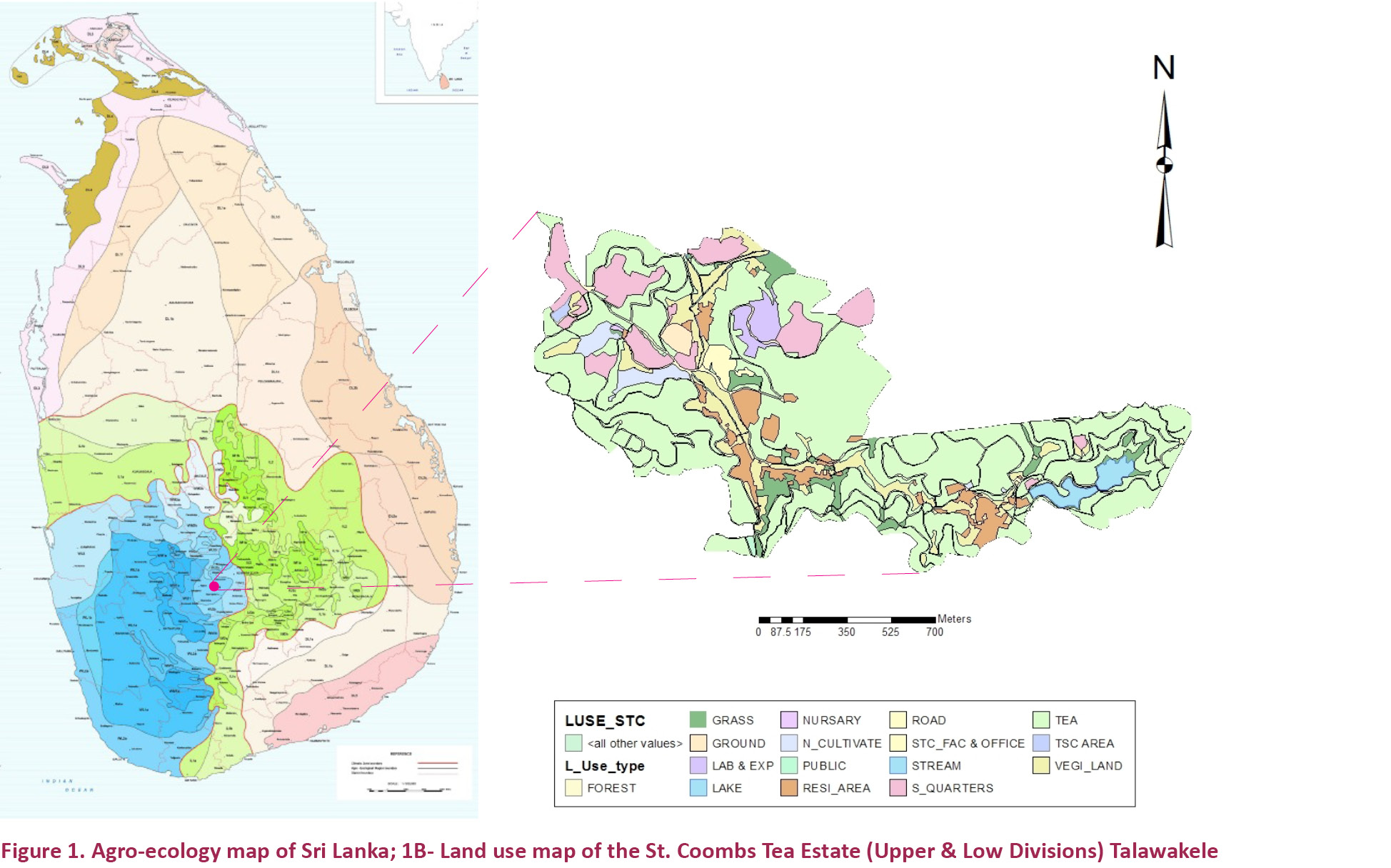
The objectives of the study were to identify the habitats, which are beneficial to bird life in tea plantation ecosystems, quantify the present status of avifaunal diversity, behavioral patterns of birds and the identification of ecosystems in St. Coombs tea estate for threatened bird species. This information could be of importance in formulating effective strategies to conserve the agro-ecosystems, to develop further studies and in particular to understand the beneficial effects of the natural avifaunal diversity to the tea plantations.
Methods
A thorough field survey was undertaken to identify different habitats in St. Coombs tea estate and based on the complexity of habitat structure, five habitats (home garden, wetland, tea plantation, Eucalyptus plantation and small scale reservoir) were chosen for the present study (Images 1–5). This was followed by the field observations on birds for a period of five years from January 2008 to December 2012. The line transect method was used in this study. The intensity of observations was two days per month. Bird counts were made along a 200x20 m line transect and 30 minutes were spent in each habitat (06.30–07.00 hr or 16.00–16.30 hr) and the same methodology was repeated in all habitats selected for the study. The time of monitoring of each habitat was planned in such a way to ensure that each habitat was monitored both in the morning as well as in the evening. The activities of birds, feeding habits and food recourses were also observed and recorded.
A pair of 7x35 binoculars (Nikon) was used to observe birds. Popular field guides including Kotagama & Fernando (1994), Harrison & Worfolk (1999) and Warakagoda et al. (2012) were used for bird identification. A pre-designed data sheet was used for the purpose of recording.
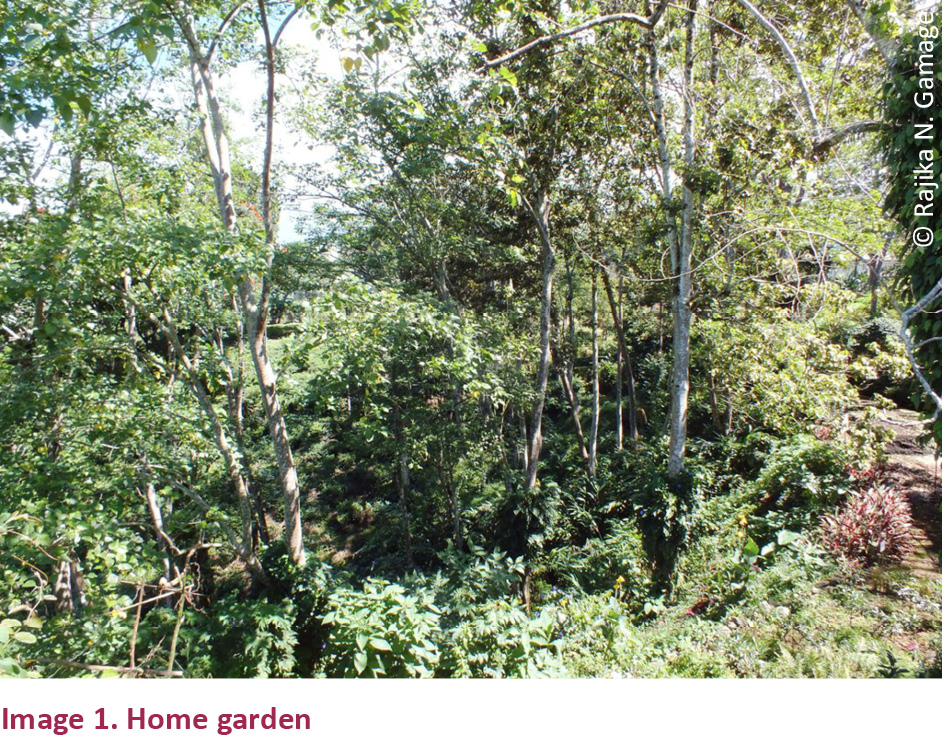
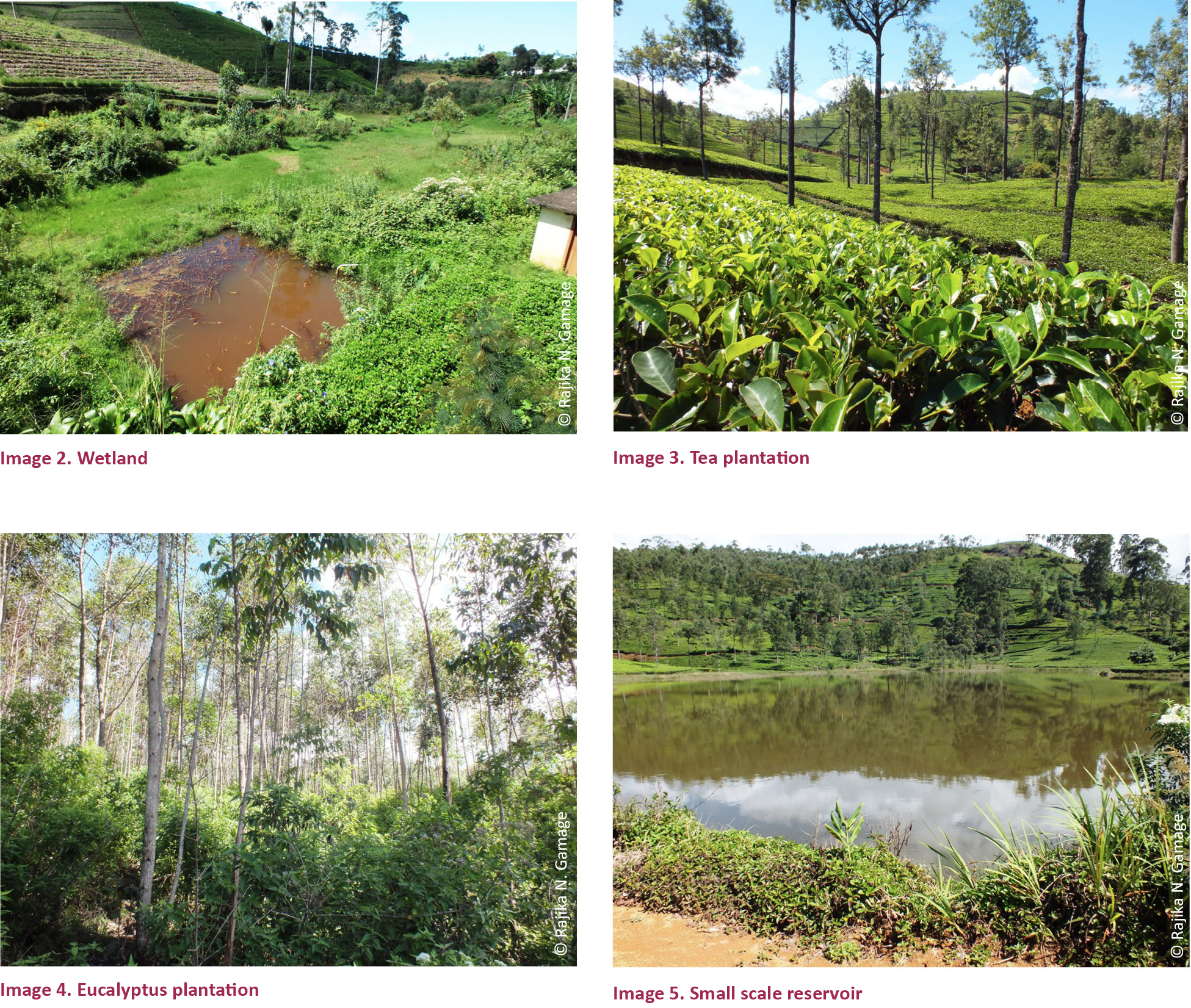
Results and Discussion
During the study period, a total of 87 species of birds including 11 species of endemics and 11 species of migrants were recorded. Among them, one globally threatened and 16 nationally threatened bird species were identified. Seventeen bird species were observed in all five habitats (Table 1) and the most encountered bird species was the Sri Lanka White-eye Zosterops ceylonensis (Image 6). Sometimes, it was observed in large flocks of 100–250 individuals.
Species diversity of different floral and faunal components of Sri Lankan home gardens depict that a wide variation exists in species assemblages of different geographic/agro-ecological regions (Pushpakumara et al. 2012). The results indicated that home garden as a habitat showed the highest bird diversity (63 species, 75% of the total recorded). The Shannon index (H’) was 3.38 and evenness (E) was 0.40. This was expected as the home garden habitat was well-structured and heterogeneous with different plant species, including woody lianas and grasses that provided more niches and food sources for birds. The avifaunal diversity was comparatively low in other habitats and their Shannon index (H’) is given in Table 2. Among the birds recorded during the survey, including the globally threatened Kashmir Flycatcher Ficedula subrubra (Image 7), Black-headed Oriole Oriolus xanthornus, Scarlet Minivet Pericrocotus flammeus, Small Minivet Pericrocotus cinncmomeus, Lesser Yellownape Picus chlorolophus, Asian Brown Flycatcher Muscicapa dauurica, Grey-headed Canary Flycatcher Culicicapa ceylonensis (Image 8) and Bar-winged Flycatcher Shrike Hemipus picatus were restricted to the home garden. During the period of the survey, Brown Wood Owl Strix leptogrammica, Emerald Dove Chalcophaps indica and a pair of Asian Koel Eudynamys scolopacea, which are very rare in the Agro-ecological region WU2a, were also recorded but only once in the home garden.
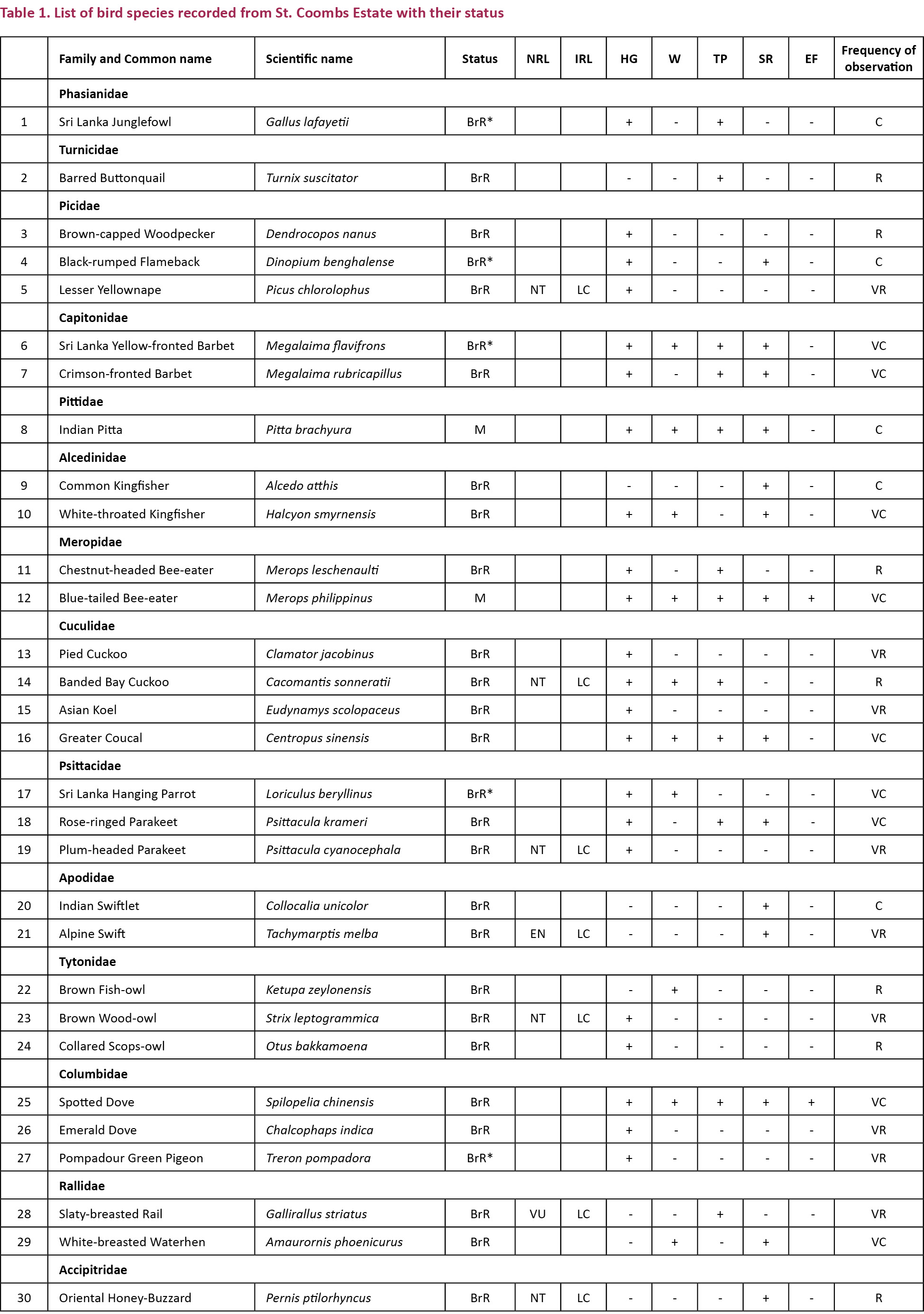
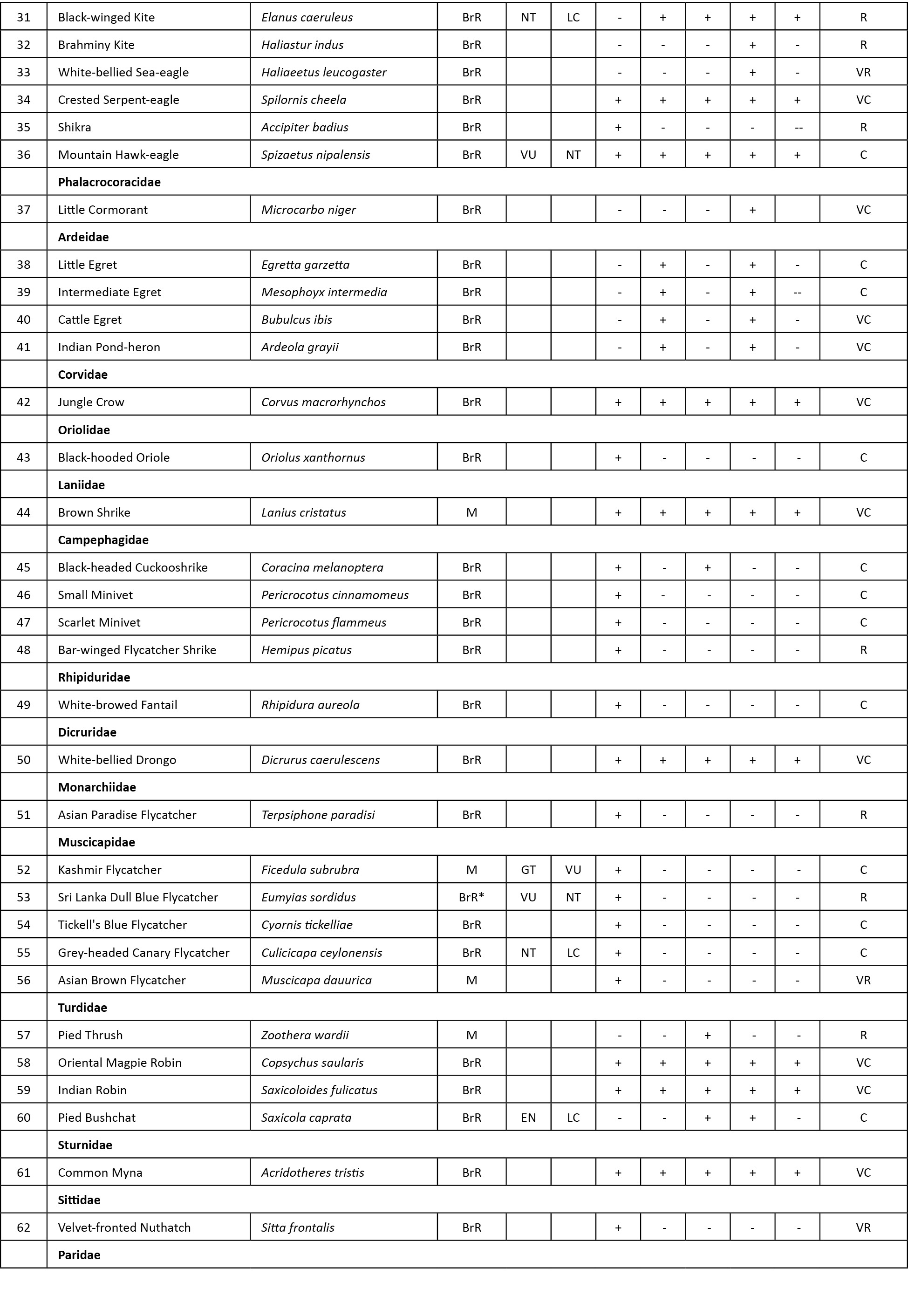
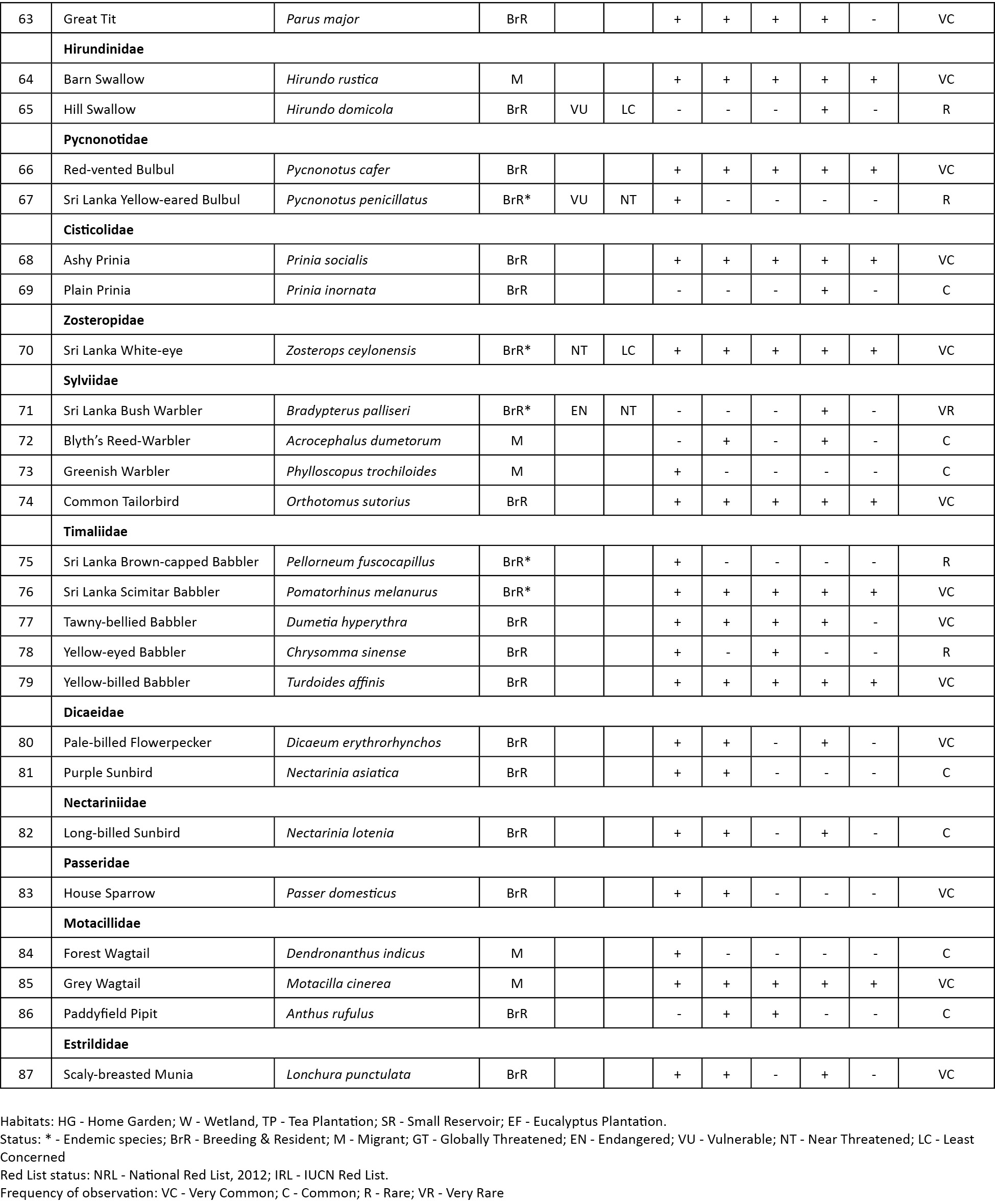
The wetland habitat is a hydrologically influenced wood-land, which is prone to regular floods during the south-west monsoon. A total of 40 bird species was recorded in this habitat (Fig. 2). The Cattle Egret Bubulcus ibis, Indian Pond Heron Ardeola grayii, White-throated Kingfisher Halcyon smyrnensis and Barn Swallow Hirundo rustica were very common at this site. Blyth’s Reed Warbler Acrocephalus dumetorum, Ashy Prinia Prinia socialis, Plain Prinia P. inornata, Common Tailorbird Orthotomus sutorius and Scaly-breasted Munia Lonchura punctulata were also frequently recorded in this habitat.
Soh et al. (2006) suggested that the poor canopy cover in the tea plantation was probably the main factor contributing to the low species richness and abundance of birds. However, few carnivorous birds such as eagles can exploit such modified habitats. The tea plantation had a low bird diversity with 35 species, accounting only for 42% of the total avifaunal diversity of the study area. Barred Buttonquail Turnix suscitator and Slaty-breasted Rail Gallirallus striatus were found only in the tea fields. Most of the insectivore birds in this site were perched on branches of shade trees such as Erythrina lithosperma, Calliandra calothrysus and Grevillea robusta.
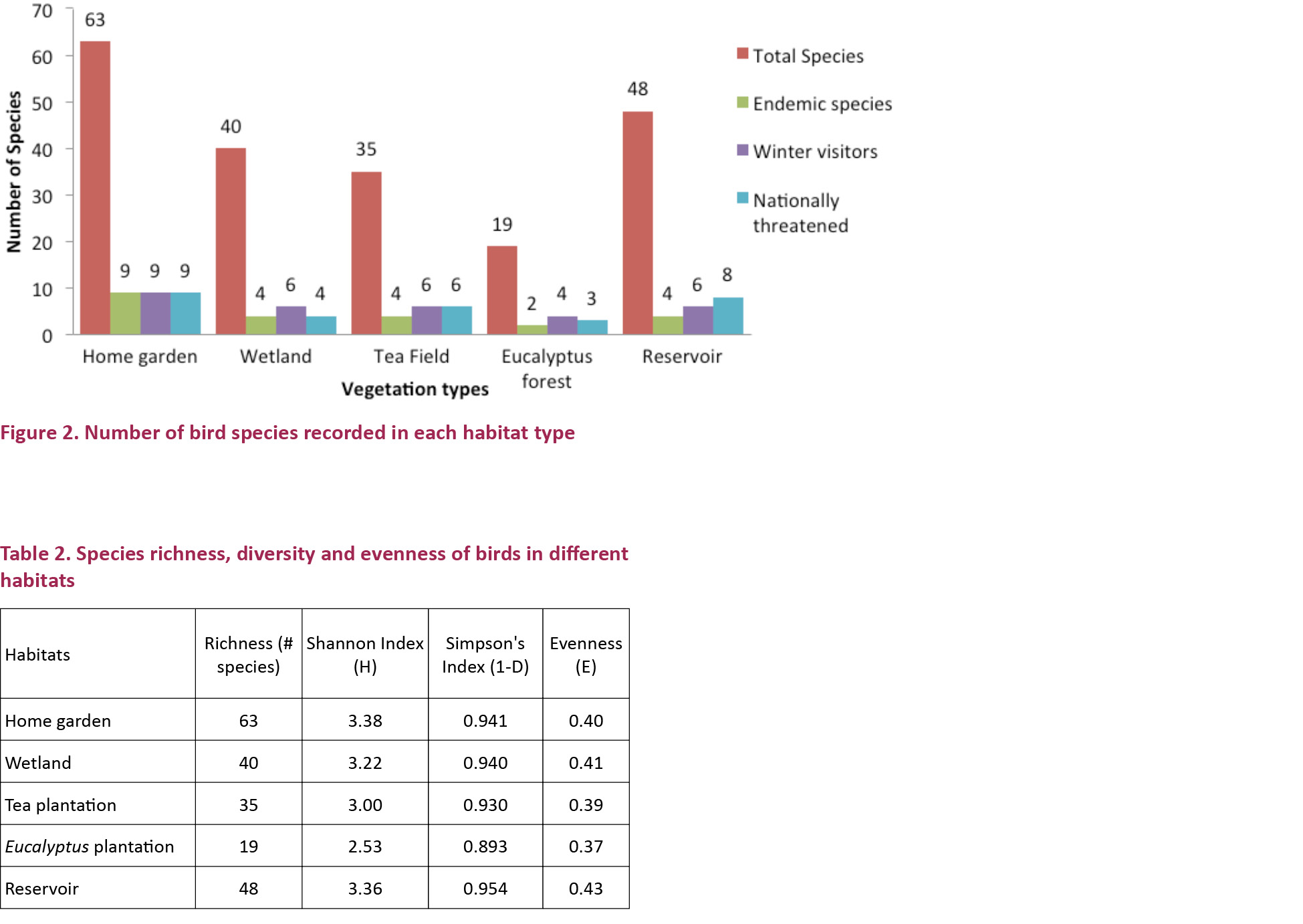
Very few bird species were observed inside the Eucalyptus plantation. They were sighted either perched on marginal Eucalyptus trees or perched on tree species such as E. lithosperma, C. calothrysus and G. robusta. Low values for Shannon (H’=2.53) and Simpson’s (1-D=0.893) diversity indices indicate the low avifaunal diversity in this habitat. Marsden et al. (2001) and Barlow et al. (2007) also observed low bird diversity in Eucalyptus plantations in the Amazonian region. The alien status of Eucalyptus, together with specific features of its leaves and bark, may explain the low suitability of Eucalyptus plantations, by limiting the presence of insects and thus the abundance of prey for birds (Calviño-Cancela 2013). Compared to the rest of the habitats, low avifauna in Eucalyptus plantations may also be a result of intensive clearance of understory vegetation. The poor avifauna in Eucalyptus plantations suggests their unsupportive status as a habitat for birds. Similarly, de la Hera et al. (2013) revealed that the Eucalyptus plantation housed the poorest bird communities, and identified understory development as an important determinant for the establishment of smaller species. Raptors such as Black-inged Kite Elanus caeruleus, Crested Serpent-eagle Spilornis cheela and Mountain Hawk-eagle Spizaetus nipalensis were found occasionally perched on branches of Eucalyptus trees searching for prey.
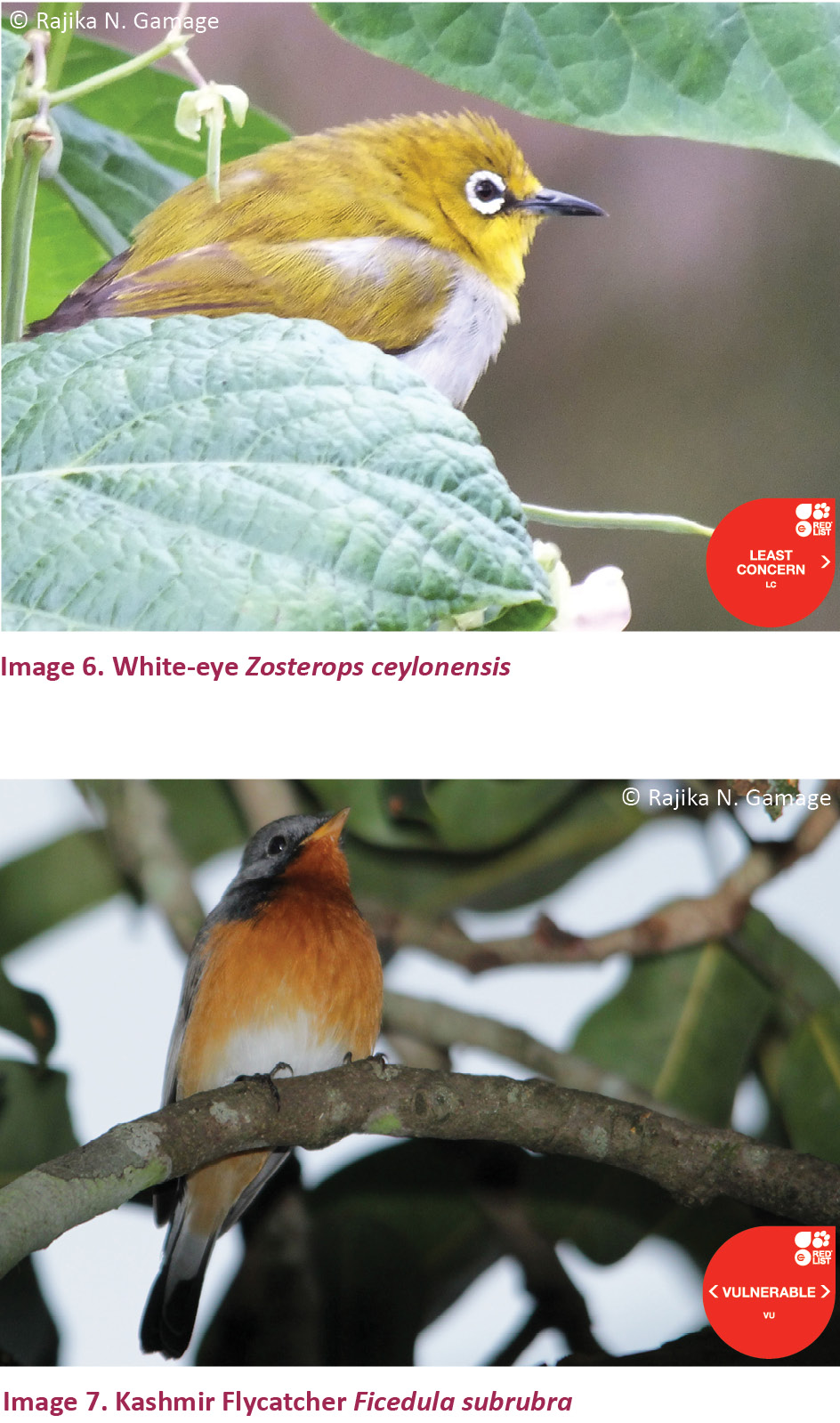
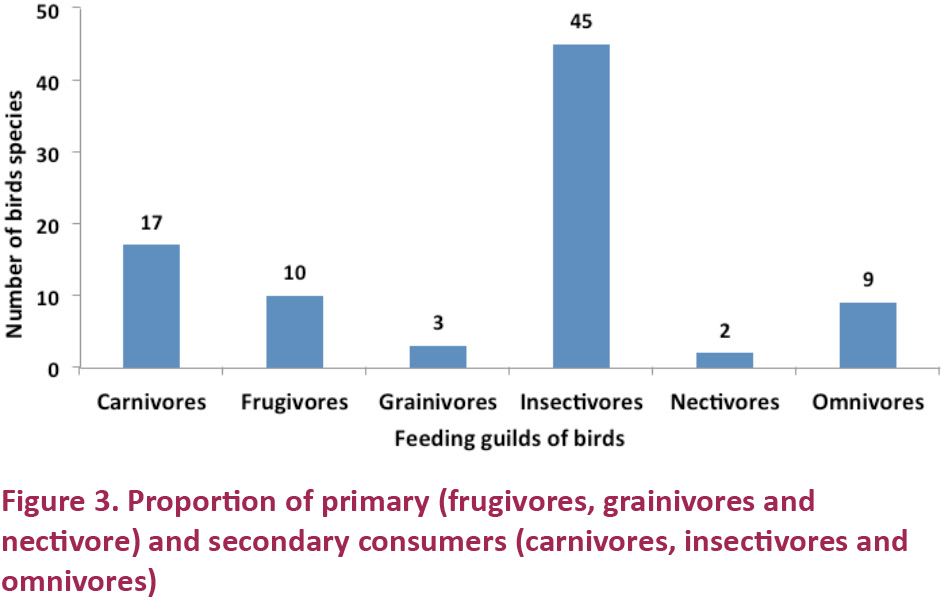

The small scale reservoir was mainly dependent on rain water and was partially dry during the dry period from March to April. During the period of survey, 48 species were observed in this habitat. Since the banks were shallow and graded, it allowed waders such as the Little Egret Egretta garzetta and Intermediate Egret Mesophoyx intermedia, Indian Pond Heron Ardeola grayii, White-throated Kingfisher Halcyon smyrnensis and Common Blue Kingfisher Alcedo atthis to hunt for food. Only Sri Lanka Bush Warbler Bradypterus palliseri and Common Blue Kingfisher were recorded from the Small scale reservoir. One small flock (5–8 individuals) of Little Cormorant Phalacrocorax niger was observed in the small scale reservoir. Large individuals of the raptors, especially eagles including, Crested Serpent-eagle and Mountain Hawk-eagle were observed in this habitat. Apart from them, the White-bellied Sea-eagle Haliaeetus leucogaster and a pair of Brahminy Kites Haliastur indus, which are normally very rare in the Agro-ecological region of WU2a, were also recorded twice in this habitat.
From a conservation perspective, it is important to analyze persistence and usage of these habitats by forest birds for their sustenance. Many typical forest bird species such as the Brown-capped Pygmy Woodpecker Dendrocopos nanus, Bar-winged Flycatcher Shrike Hemipus picatus, Sri Lanka Brown-capped Babbler Pellorneum fuscocapillus (Image 12), Grey-headed Canary Flycatcher Culicicapa ceylonensis, Sri Lanka Dull Blue Flycatcher Eumyias sordidus (Image 13) and Velvet-fronted Nuthatch Sitta frontalis were not found in tea fields, but were observed only in adjoining home gardens. Common migrant species recorded in the Sri Lankan montane ecosystem such as the Indian Blue Robin Erithacus brunneus and Large-billed Leaf Warbler Phylloscopus magnirostris were not recorded during the present study. However, two migrant species, Grey Wagtail Montacilla cinerea and Forest Wagtail Dendronanthus indicus were observed in habitat openings, home gardens and estate roads in the plantation.
The responses of endemic and priority species to habitat alteration were mostly characteristic. Posa & Sodhi (2006) mentioned that forest bird species were positively correlated with vegetation variables such as canopy cover, tree density and ground cover. In general, alteration in habitat structure, particularly of woody plant variables, affected their richness and abundance, suggesting the importance of niches and floristic attributes for the persistence of these species. Forest-edge species, including the endemic Sri Lanka Jungle Fowl Gallus lafayetii (Image 14), Sri Lanka Hanging Parrot Loriculus beryllinus (Image 15) and Sri Lanka Scimitar Babbler Pomatorhinus melanurus (Image 16, were also present in the tea plantation ecosystem as it characterized a suitable habitat. A significant reduction (from around 250–100 of individuals in a flock) of the Sri Lanka White-Eye was observed during the study period.
Distribution of feeding guilds of birds
Another aspect of conservation relevance is to consider, whether these plantations provide resources for birds throughout the year. Tea plantations represent a poorer habitat for rainforest birds, because of the fallouts and fragments in the landscape (Raman 2006). Tea plantations that consist mainly of exotic trees such as Eucalyptus, C. calothrysus and G. robusta may offer few resources for frugivorous and nectarivorous birds. The representation of grainivores and nectarivores was very low (Fig. 3). Similarly, Barlow et al. (2007) observed an increase in the detection of canopy frugivores and seed predators during the peak of flowering and fruiting in primary forests, but failed to suggest that Eucalyptus plantation provided suitable foraging habitat at any time of the year .
Tea plantations may only temporarily support frugivores such as Yellow-fronted Barbet Megalaima flavifrons (Image 17), Crimson-fronted Barbet M. rubricapillus and Black-hooded Oriole Oriolus xanthornus that visit the scattered fruiting trees (e.g., Ficus sp., Persea americana, Psidium guajava, P. littorale and Mangifera indica). Nectar-feeding birds such as sunbirds visited flowers of exotics such as E. lithosperma, C. calothrysus and S. campanulata, in addition to flowers of native plants. In the more open tea plantations, a garden species, Long-billed Sunbird Nectarinia lotenia was more abundant than the Purple Sunbird Nectarinia asiatica.
On the other hand, large numbers of insectivores were observed during the study period. For example, 45 out of 87 of the bird species were insectivores. The study revealed that most of the insectivores fed on flying insects. The high number of avifaunal observations made on the shade tree species of Calliandra calothrysus, Grevillea robusta and Spathodea campanulata could be due to the fact that they are wide spread throughout the plantation and provide micro habitats for the various needs of the avifauna.
During the study period, two nests (tree holes) of Crimson-fronted Barbet and Yellow-fronted Barbet were observed on the dead branches of avocado P. americana and Ficus trees in home gardens, respectively. Few nests of Scaly-breasted Munia Lonchura punctulata were observed throughout the year in home gardens. Two adults of Oriental Magpie-Robin Copsychus saularis were seen carrying food material in September 2012. A juvenile of Greater Coucal Centropus sinensis accompanied by two adults were seen in Home gardens. Two nests of Sri Lanka White-eye Zosterops ceylonensis were noticed in the tea plantation and the nests were seen on the fork of tea C. sinensis bushes at a height of about 1m. The nests were built by the fibres and leaves of various grasses. Two adults of Plain Prinia Prinia inornata with two juveniles were recorded in the wetland habitat.
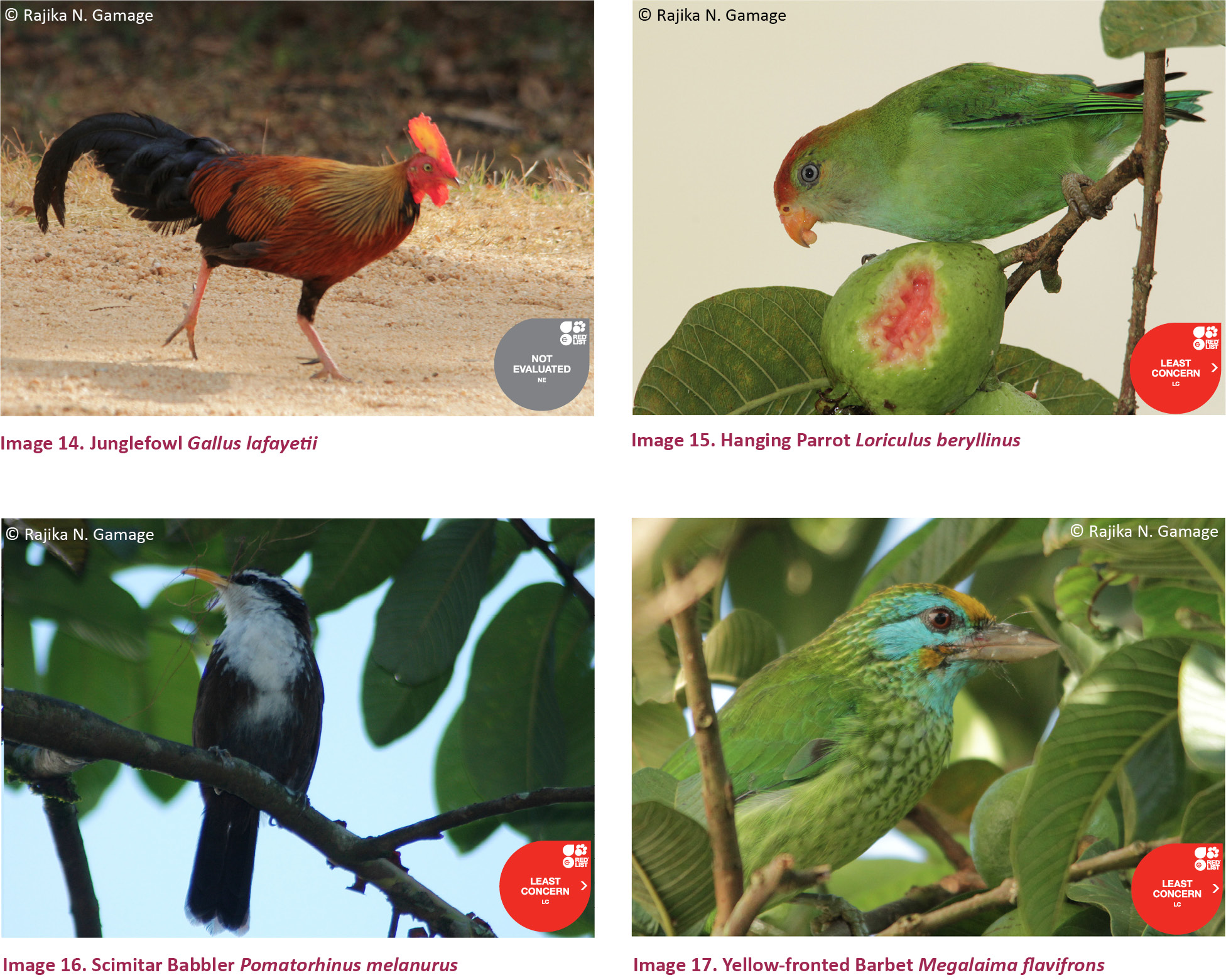
Threats to the avifauna of the region
Nearly one-third of all the resident birds in Sri Lanka are forest birds, including all the endemic species. Out of the endemic birds, more than 60% are restricted to the forests in the wet zone (Weerakoon & Gunawardena 2012). These forests are being rapidly depleted to support the needs of the burgeoning human population. Therefore, loss of forest cover and fragmentation of forests are the main threats faced by the birds of Sri Lanka. Narayanan et al. (2011) also revealed that landscape alteration, hunting, felling of nesting trees and pesticides are the major detrimental factors for the survival of birds.
A considerable extent of habitat destruction and modifications were observed during the study period in St. Coombs tea estate. Most wetlands and seasonal streams of the study area, which provided habitats for waterfowls, grassland birds and egrets, have been converted to agricultural lands. Setting fire to grasslands and scrub vegetation were observed during the dry season. These activities adversely affected the migratory birds such as warblers and Pitta by reducing available roosting and foraging areas as well as food. Dead trees in home gardens and tea fields which could be used to make holes by barbets and woodpeckers for nesting are being removed for firewood regularly. Furthermore, it could directly affect the nesting sites of resident avifauna.
Regular human movement through tea fields and noises from vehicles may have affected the behavior of forest birds. These activities may have caused to reduce such species in tea ecosystem, when compared to natural forests. On the other hand, the population of the Jungle Crow Corvus macrorhynchos drastically increased as a result of garbage accumulation. It was observed that groups of crows extensively predated on birds including their eggs and juveniles. They were also responsible for destroying bird nests.
An increase in plant diversity with native nectarine species and fruit-bearing plants was observed in home gardens and road sides which could have improved avifaunal diversity. Thus, the importance of maintaining large natural forest cannot be overemphasized in order to conserve the diversity of forest birds. In this context, plantations with a mixture of indigenous tree species may serve well to compensate for the loss in forest areas, as their bird species richness and community composition closely resembled natural forests (Farwig et al. 2008). Increasing plant diversity with native species in the abandoned lands, home gardens and road sides and creating awareness of the detrimental effects of excessive use of agro-chemicals among the estate community would certainly bring the necessary beneficial changes to these ecosystems. Further studies are needed on ecology, behavior, population dynamics and interaction with human activities in plantation ecosystems.
Conclusion
Out of the five habitats selected for this study at St. Coombs tea estate, home gardens stand out as the best site for birds, followed by the small scale reservoir. The current study shows that home gardens support bird diversity including a large proportion of endemic bird species thereby enabling these findings to be used as guidelines in long term conservational practices. Several conservation measures such as increasing plant diversity, introduction of shade trees and prevention of fire are recommended to protect and conserve avifaunal diversity in tea plantations.
ReferenceS
Anonymous (1999). Biodiversity conservation in Sri Lanka: A framework for action. Ministry of Forestry and Environment, Sri Lanka, 126pp.
Bambaradeniya, C.N., M.S. Perera, W.P. Perera, L.M. Wickramasinghe, L.D. Kekulandala, V.A.P. Samarawickrema, R.H.S.S. Fernando & V.A.M.P.K. Samarawickrema (2003). Composition of faunal species in the Sinheraja world heritage site in Sri Lanka. The Sri Lanka Forester 26: 21–40.
Barlow, J., L.A.M. Mestrec, T.A. Gardner & C.A. Peres (2007). The value of primary, secondary and plantation forests for Amazonian birds. Biological Conservation 136: 212–231; http://dx.doi.org/10.1016/j.biocon.2006.11
Calviño-Cancela, M. (2013). Effectiveness of eucalypt plantations as a surrogate habitat for birds. Forest Ecology and Management 310: 692–699; http://dx.doi.org/10.1016/j.foreco.2013.09.014
de la Hera, I., J. Arizaga & A. Galarza (2013). Exotic tree plantations and avian conservation in northern Iberia: a view from a nest-box monitoring study. Animal Biodiversity and Conservation 36(2): 153–163.
Farwig, N., N. Sajita & K. Bohning-Gaese (2008). Conservation value of forest plantations for bird communities in western Kenya. Forest Ecology and Management 255: 3885–3892; http://dx.doi.org/10.1016/j.foreco.2008.03.042
Gunaratne, A.M., & C.V. Gunatilleke (2003). Avifaunal diversity and plant-bird interactions in three selected habitats of lawer Hantana (Campus Land), Sri Lanka. The Sri Lanka Forester 26: 41–52.
Harrison, J. & T. Worfolk (1999). A Field Guide to The Birds of Sri Lanka. Oxford University Press, 219pp.
Hettige, U.S.B., L.J.M. Wikramasinghe, T.G.M. Piyadarshana, K. Gunawardana, L.I. Perera & A. Manorathna (2000). Fauna of Gal-oya National Park. Sri Lanka Naturalist 3(4): 55–61.
Kotagama, S. & P. Fernando (1994). A Field Guide to The Birds of Sri Lanka. Wildlife Heritage Trust of Sri Lanka, 224pp.
Kottawa-Arachchi J.D., R.N. Gamage, H.A.C.K. Ariyarathne & G.G. Jayathilake (2010). Avifaunal diversity in a tea plantation ecosystem in the up-country of Sri Lanka, pp. 318–327. In: Proceedings of the 15th International Forestry and Environment Symposium 2010, University of Sri Jayewardenepura, Sri Lanka.
Marsden, S.J., M. Whiffin & M. Galetti (2001). Bird diversity and abundance in forest fragments and Eucalyptus plantations around an Atlantic forest reserve, Brazil. Biodiversity and Conservation 10: 737–751.
Ministry of Environment (2012). The National Red List 2012 of Sri Lanka; Conservation Status of the Fauna and Flora. Ministry of Environment, Colombo, Sri Lanka, 476pp
Narayanan, S.P., A.P. Thomas & B. Sreekumar (2011). Ornithofauna and its conservation in the Kuttanad wetlands, southern portion of Vembanad-Kole Ramsar site, India. Journal of Threatened Taxa 3(4): 1663–1676; http://dx.doi.org/10.11609/JoTT.o1870.1663-76
Panabokke, C.R. & R.P. Kannangara (1996). Agro-ecological regions of Sri Lanka: Map 2. Survey Department of Sri Lanka.
Posa, M.R.C. & N.S. Sodhi (2006). Effects of anthropogenic land use on forest birds and butterflies in Subic Bay, Philippines. Biological Conservation 129: 256–270; http://dx.doi.org/10.1016/j.biocon.2005.10.041
Pushpakumara, D.K.N.G., B. Marambe, G.L.L.P. Silva, J. Weerahewa & B.V.R. Punyawardena (2012). A review of research on Homegardens in Sri Lanka: the status, importance and future perspective. Tropical Agriculturist 160: 55–125.
Raman, T.R.S. (2006). Effects of habitat structure and adjacent habitats on birds in tropical rainforest fragments and shaded plantations in the Western Ghats, India. Biodiversity and Conservation 15: 1577–1607; http://dx.doi.org/10.1007/s10531-005-2352-5
Rasmussen, P.C. & J.C. Anderton (2005). Birds of South Asia: The Ripley Guide, Vols. 1 and 2. Smithsonian Institute and Lynux Editions, Washington, D.C. and Barcelona, 683pp.
Soh, M.C.K., N.S. Sodhi & S.L.H. Lim (2006). High sensitivity of montane bird communities to habitat disturbance in Peninsular Malaysia. Biological Conservation 129: 149–166; http://dx.doi.org/10.1016/j.biocon.2005.10.030
Surasinghe, T.D. & C. De Alwis (2010). Birds of Sabaragamuwa University campus, Buttala, Sri Lanka. Journal of Threatened Taxa 2(5): 876–888; http://dx.doi.org/10.11609/JoTT.o2113.876-88
Warakagoda, D., I. Inskipp, T. Inskipp & R. Grimmett (2012). Birds of Sri Lanka. Christopher Helm, an imprint of Bloomsberry Publishing Plc. 224pp.
Weerakoon, D.K. & W.L.D.P.T.S.A. Goonatilleke (2007). Diversity of avifauna in the Wilpattu National Park. Siyoth 2(2): 7–15.
Weerakoon, D.K. & K. Gunawardena (2012). The taxonomy and conservation status of birds in Sri Lanka. pp 114-117. In: Weerakoon, D.K. & S. Wijesundara (eds.). The National Red List 2012 of Sri Lanka; Conservation Status of the Fauna and Flora. Ministry of Environment, Colombo, Sri Lanka.